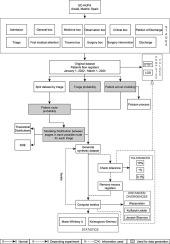急诊科病人流动的可解释统计模型。
IF 4.5
2区 医学
Q2 COMPUTER SCIENCE, INTERDISCIPLINARY APPLICATIONS
引用次数: 0
摘要
目的:本文旨在开发一个数据驱动的仿真框架,在缺乏系统资源数据的情况下,使用可解释的方法对医院急诊科的整个流程进行建模。目标是提高对系统动力学的理解,并通过透明的模拟支持决策过程,即使在资源数据不可用的情况下也是如此。方法:我们利用西班牙一家医院急诊科的匿名医疗记录开发了一个模拟框架。该模型通过识别路线和测量每个阶段之间的过渡时间来捕获考虑分诊级别的患者流量。我们使用参数(理论)分布和非参数核密度估计(KDE)来估计这些过渡。病人入院时间用概率分布建模。我们通过由容忍阈值和定量度量指导的迭代改进过程增强了现实性。该过程将合成数据细化到与原始分布相匹配。结果:我们的方法在迭代方法中产生了具有低容差值的高度逼真的患者流模拟。这个过程逐渐向原始数据收敛。距离和散度指标以及统计测试结果表明,模拟与实际数据高度相似,当容差阈值较低时,100%的生成样本同时通过了Mann-Whitney U和Kolmogorov-Smirnov测试。结论:实验结果表明,即使在缺乏与服务资源相关的信息的情况下,我们的模拟方法也能有效地再现患者流动动力学,具有很高的真实感和灵活性。其可解释的设计和可调整的参数使安全的数据分析和探索替代管理策略(例如,修改潜在的病人路线或限制一些过渡)。这些特点使该方法成为支持知情决策的宝贵工具,并表明其在其他具有适当数据的医院中使用的潜力,有待外部数据集的验证。本文章由计算机程序翻译,如有差异,请以英文原文为准。

Interpretable statistical modeling of patient flow in emergency departments
Objective:
This paper aims to develop a data-driven simulation framework for modeling patient flow in a hospital Emergency Department using interpretable methods throughout the entire process in the absence of system resource data. The goal is to improve understanding of system dynamics and support decision-making processes through transparent simulations, even when resource data are unavailable.
Methods:
We developed a simulation framework using anonymized medical records from a Spanish hospital’s Emergency Department. The model captures patient flow considering triage levels by identifying routes and measuring the transition times between each stage in them. We estimated these transitions using both parametric (theoretical) distributions and non-parametric Kernel Density Estimation (KDE). Patient admissions times are modeled by using probability distributions. We enhanced realism through an iterative refinement process guided by tolerance thresholds and quantitative metrics. This process refined the synthetic data to match the original distributions.
Results:
Our approach produces highly realistic patient flow simulations with low tolerance values in the iterative method. The process gradually converges toward the original data. Distance and divergence metrics, together with statistical test results, indicate a high degree of similarity between the simulations and the real data, passing the Mann–Whitney U and Kolmogorov–Smirnov tests simultaneously in 100% of the generated samples when the tolerance threshold is low.
Conclusion:
The experimental results demonstrate that our simulation method effectively reproduces patient flow dynamics with a high level of realism and flexibility, even in the absence of information related to service resources. Its interpretable design and adjustable parameters enable safe data analysis and the exploration of alternative management strategies (e.g., modifying potential patient routes or restricting some transitions). These features position the methodology as a valuable tool for supporting informed decision-making and suggest its potential for use in other hospitals with suitable data, pending validation on external datasets.
求助全文
通过发布文献求助,成功后即可免费获取论文全文。
去求助
来源期刊

Journal of Biomedical Informatics
医学-计算机:跨学科应用
CiteScore
8.90
自引率
6.70%
发文量
243
审稿时长
32 days
期刊介绍:
The Journal of Biomedical Informatics reflects a commitment to high-quality original research papers, reviews, and commentaries in the area of biomedical informatics methodology. Although we publish articles motivated by applications in the biomedical sciences (for example, clinical medicine, health care, population health, and translational bioinformatics), the journal emphasizes reports of new methodologies and techniques that have general applicability and that form the basis for the evolving science of biomedical informatics. Articles on medical devices; evaluations of implemented systems (including clinical trials of information technologies); or papers that provide insight into a biological process, a specific disease, or treatment options would generally be more suitable for publication in other venues. Papers on applications of signal processing and image analysis are often more suitable for biomedical engineering journals or other informatics journals, although we do publish papers that emphasize the information management and knowledge representation/modeling issues that arise in the storage and use of biological signals and images. System descriptions are welcome if they illustrate and substantiate the underlying methodology that is the principal focus of the report and an effort is made to address the generalizability and/or range of application of that methodology. Note also that, given the international nature of JBI, papers that deal with specific languages other than English, or with country-specific health systems or approaches, are acceptable for JBI only if they offer generalizable lessons that are relevant to the broad JBI readership, regardless of their country, language, culture, or health system.
 求助内容:
求助内容: 应助结果提醒方式:
应助结果提醒方式:


